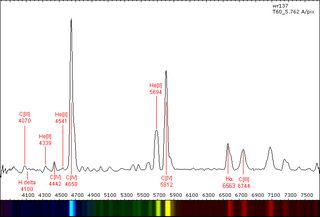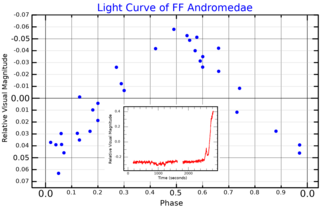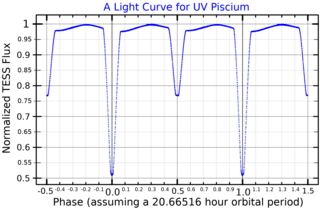
Castor is the second-brightest object in the zodiac constellation of Gemini. It has the Bayer designation α Geminorum, which is Latinised to Alpha Geminorum and abbreviated Alpha Gem or α Gem. With an apparent visual magnitude of 1.58, it is one of the brightest stars in the night sky. Castor appears singular to the naked eye, but it is actually a sextuple star system organized into three binary pairs. Although it is the 'α' (alpha) member of the constellation, it is half a magnitude fainter than 'β' (beta) Geminorum, Pollux.

VV Cephei, also known as HD 208816, is an eclipsing binary star system located in the constellation Cepheus. It is both a B[e] star and shell star.

II Pegasi is a binary star system in the constellation of Pegasus with an apparent magnitude of 7.4 and a distance of 130 light-years. It is a very active RS Canum Venaticorum variable, a close binary system with active starspots.

HR Carinae is a luminous blue variable star located in the constellation Carina. It is surrounded by a vast nebula of ejected nuclear-processed material because this star has a multiple shell expanding atmosphere. This star is among the most luminous stars in the Milky Way. It has very broad emission wings on the Balmer lines, reminiscent from the broad lines observed in the spectra of O and Wolf–Rayet stars. A distance of 5 kpc and a bolometric magnitude of −9.4 put HR Car among the most luminous stars of the galaxy.

HR 7578 is a triple star system in the constellation of Sagittarius. Their combined apparent magnitude is 6.18. Parallax measurements by the Gaia spacecraft put the system at 46 light-years away, making this a nearby system.

Sigma Coronae Borealis is a star system in the constellation of Corona Borealis. It is a quintuple star system containing three sunlike main-sequence stars and two other low-mass stars. The combined visual magnitude is 5.3 and the system lies 74 light years from Earth. σ CrB A is the variable star TZ Coronae Borealis.

WR 137 is a variable Wolf-Rayet star located around 6,000 light years away from Earth in the constellation of Cygnus.

CH Cygni is a red giant, variable, symbiotic binary in the constellation Cygnus. It is the nearest symbiotic star to Earth, and one of the brightest, making it an ideal candidate for study.

FF Andromedae is a spectroscopic binary in the constellation Andromeda. It has a typical apparent visual magnitude of 10.4, but undergoes flare events that can increase its brightness by about a magnitude.

HD 165590 is a quintuple system dominated by the binary Algol variable star known as V772 Herculis. The system lies in the constellation of Hercules about 123 light years from the Sun, and is suspected to be a part of the Pleiades moving group.

LQ Hydrae is a single variable star in the equatorial constellation of Hydra. It is sometimes identified as Gl 355 from the Gliese Catalogue; LQ Hydrae is the variable star designation, which is abbreviated LQ Hya. The brightness of the star ranges from an apparent visual magnitude of 7.79 down to 7.86, which is too faint to be readily visible to the naked eye. Based on parallax measurements, this star is located at a distance of 59.6 light years from the Sun. It is drifting further away with a radial velocity of 7.6 km/s.

XY Ursae Majoris is a short period binary star system in the northern circumpolar constellation of Ursa Major. It is an eclipsing binary with a baseline apparent visual magnitude of 9.50. The system is located at a distance of 221.5 light years from the Sun based on parallax measurements, but is drifting closer with a radial velocity of −10 km/s. It has a relatively high proper motion, traversing the celestial sphere at the angular rate of 0.191″·yr−1.

SZ Piscium is a suspected triple star system in the equatorial constellation of Pisces. The inner pair form a double-lined spectroscopic binary with an orbital period of 3.966 days. It is a detached Algol-type eclipsing binary of the RS Canum Venaticorum class with a subgiant component. The system is too faint to be readily visible to the naked eye with a combined apparent visual magnitude of 7.18. It is located at a distance of approximately 306 light years based on parallax measurements.

UV Piscium is a binary star system in the constellation of Pisces. With a peak apparent visual magnitude of 8.98, it is too faint to be visible to the naked eye. This is an eclipsing binary system that decreases to magnitude 10.05 during the primary eclipse, then to magnitude 9.54 with the secondary eclipse. It is located at a distance of 232 light years from the Sun based on parallax measurements, and is receding with a radial velocity of 6.5 km/s. The position of this star near the ecliptic means it is subject to lunar occultation.

ER Vulpeculae is a binary star system in the northern constellation of Vulpecula, abbreviated ER Vul. It is a variable star system with a brightness that ranges from an apparent visual magnitude of 7.27 down to 7.49, which is too faint to be visible to the naked eye. This system is located at a distance of 165 light years from the Sun based on parallax measurements. It is drifting closer with a radial velocity of −25 km/s.

YY Mensae, also known as HD 32918, is a variable star located in the southern circumpolar constellation Mensa. It has an apparent magnitude that fluctuates between 8.6 and 8.9, which is within the visibility of binoculars. Based on parallax measurements from Gaia DR3, it is estimated to be 715 light years distant. It appears to be approaching the Solar System with a heliocentric radial velocity of −8.5 km/s.

DM Ursae Majoris is a binary star system in the northern circumpolar constellation of Ursa Major, abbreviated DM UMa. It is sometimes identified by the Bonner Durchmusterung catalogue designation BD +61 1211; DM UMa is the variable star designation. The system has a combined apparent visual magnitude of 9.29, which is too faint to be visible to the naked eye. Based on parallax measurements, the system is located at a distance of approximately 606 light years from the Sun, but it is drifting closer with a heliocentric radial velocity of −7 km/s.

HD 224355, also known as V1022 Cassiopeiae, HR 9059 and Boss 6148, is an eclipsing binary star in the constellation Cassiopeia. It ranges in apparent magnitude from 5.57 to 5.68, which means it is faintly visible to the naked eye for an observer located well away from city lights. It is one of the few binaries known to be an astrometric, spectroscopic and eclipsing binary, a combination that allows the parameters of the stellar system to be calculated with high accuracy. HD 224355 lies 16′ west of the 5th-magnitude σ Cassiopeiae.

HR 1099 is a triple star system in the equatorial constellation of Taurus, positioned 11′ to the north of the star 10 Tauri. This system has the variable star designation V711 Tauri, while HR 1099 is the star's identifier from the Bright Star Catalogue. It ranges in brightness from a combined apparent visual magnitude of 5.71 down to 5.94, which is bright enough to be dimly visible to the naked eye. The distance to this system is 96.6 light years based on parallax measurements, but it is drifting closer with a radial velocity of about −15 km/s.

AR Piscium is a binary star system in the northern constellation of Canes Venatici, abbreviated AR Psc. It has the Henry Draper Catalogue identifier HD 8357; AR Piscium is its variable star designation. The pair have a combined apparent visual magnitude that fluctuates around 7.24, which is too faint to be readily visible to the naked eye. Parallax measurements place it at a distance of 148 light years from the Sun. The motion of this star through the Milky Way suggests it is a member of the intermediate disc population.





















